NON CHILL
FILTERED
WHAT IS
CHILL FILTERING?
The process of ‘chill filtering’ is widespread across the whiskey industry with the vast majority of distillers using this process to remove unwanted substances from their whiskeys before bottling.
The rationale for using ‘chill filtering’ is primarily cosmetic. A whiskey with an ABV below 45%, which has not been chill-filtered, will become cloudy when ice is added, or when it is cooled. This natural phenomenon is seen as undesirable by consumers and manufacturers alike, so distillers have responded by removing these naturally occurring particles in the whiskey through the process of ‘chill filtering’ before bottling. Whiskey of 46% ABV and above do not suffer from this problem as higher alcohol level stops the cloudiness from forming.
WHAT CAUSES
THIS CLOUDINESS?
This cloudiness is caused by the presence of natural fatty acids, esters and proteins in the whiskey. These all occur during the distillation process and some are imparted from the wooden casks during the long maturation period. When whiskey is cooled down these naturally occurring fatty acids, proteins, and esters clump together causing a cloudiness, referred to as ‘whiskey haze’.
A whiskey that is not chill filtered may also develop sediment at the bottom of the bottle over the years if stored in a cool place. Unfortunately, both sediment and cloudiness are seen as undesirable by the wider whiskey drinking community. During the early 20th Century it was discovered that this perceived ‘whiskey haze’ imperfection could be ‘fixed’ by filtering them out of the whiskey at a low temperature before bottling. The result was that these naturally occurring elements in the aged whiskey could be removed easily by this chilled filtration process.
THE CHILL
FILTERING PROCESS:
The process of chill filtering involves dropping the temperature of the whiskey down to 0º Celsius in the case of single malts and to -4º Celsius in the case of whiskey blends. The chill temperatures for whiskey blends are cooler as they contain grain whiskey and have a lower naturally occurring concentration of fatty acids. Once chilled, the whiskey is passed, under high pressure, through a series of very tightly woven metallic meshes.
The amount of residue collected depends on the number of metal filters, the pressure level and the flow rate. The slower a whiskey is passed through a chill filtering process; the more residues are collected in the filters. During this process any other sediment or ‘coals’ present in the whiskey will also be removed
GOOD OR BAD?
At HYDE we DO NOT chill filter any of our single malts. We believe in producing a more natural whiskey, retaining the full character and taste imparted by its cask and the long aging and maturing process. The removal of all the naturally occurring fatty acids, esters, and proteins form the original single malt whiskey affects the final flavour profile and original character. We believe that true whiskey connoisseurs can taste the difference.



